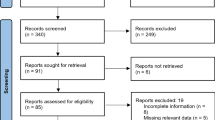Abstract
Background The computerization of prescriptions with a computerized physician order entry contributes to securing the error-free drug supply, but is not risk-free. Objective: To determine the impact of a computerized physician order entry system on prescribing errors immediately after its implementation and 1 year later. Setting The Cardiology and Diabetology Departments at Toulouse University Hospital, France. Method The prescriptions were analysed by pharmacists over three 30-day periods for 3 consecutive years (N: computerization period, N − 1, N + 1). For each identified error, the prescriber was informed by a pharmaceutical intervention. The pharmaceutical interventions were counted and arranged according to the classification by the French Society of Clinical Pharmacy. Their average numbers and clinical impacts were compared for each period using t-tests and Kruskal–Wallis tests. Main outcome measure The average numbers of pharmaceutical interventions. Results In total, 12.1 pharmaceutical interventions per 100 patient days were done during the N − 1 period, 14.1 during N and 9.6 during N + 1. Among those, 3.6 (N) and 2.1 (N + 1) were related to the computerization itself, and 10.5 (N) and 7.5 (N + 1) were not. The average number of computerization-related pharmaceutical interventions significantly decreased from N to N + 1 (p = 0.04). The average number of classic interventions decreased from N − 1 to N + 1 (p = 0.02). The clinical impacts of the computerization related errors were similar to those of other errors. Conclusion The implementation of the computerized physician order entry induced the appearance of specific computerized-related errors, but the number of classic errors decreased. The entry-system related errors were not more severe than other errors, and the number decreased after 1 year.



Similar content being viewed by others
References
Bates DW, Teich JM, Lee J, Seger D, Kuperman GJ, Ma’Luf N, et al. The impact of computerized physician order entry on medication error prevention. J Am Med Inform Assoc. 1999;6:313–21.
Reckmann MH, Westbrook JI, Koh Y, Lo C, Day RO. Does computerized provider order entry reduce prescribing errors for hospital inpatients? a systematic review. J Am Med Inform Assoc. 2009;16:613–23.
Charpiat B, Bedouch P, Conort O, Rose FX, Juste M, Roubille R, et al. Opportunities for medication errors and pharmacist’s interventions in the context of computerized prescription order entry: a review of data published by French hospital pharmacists. Ann Pharm Fr. 2012;70:62–74.
Charles K, Cannon M, Hall R, Coustasse A. Can utilizing a computerized provider order entry (CPOE) system prevent hospital medical errors and adverse drug events? Perspect Health Inf Manag. 2014;11:1b.
Nuckols TK, Smith-Spangler C, Morton SC, Asch SM, Patel VM, Anderson LJ, et al. The effectiveness of computerized order entry at reducing preventable adverse drug events and medication errors in hospital settings: a systematic review and meta-analysis. Syst Rev. 2014;3:56.
Koppel R, Metlay JP, Cohen A, Abaluck B, Localio AR, Kimmel SE, et al. Role of computerized physician order entry systems in facilitating medication errors. J Am Med Assoc. 2005;293:1197–203.
Ash JS, Sittig DF, Dykstra RH, Guappone K, Carpenter JD, Seshadri V. Categorizing the unintended sociotechnical consequences of computerized provider order entry. Int J Med Inf. 2007;76:S21–7.
Bouchand F, Thomas A, Zerhouni L, Dauphin A, Conort O. Pharmacists’ interventions before and after prescription computerization in an internal medicine department. Presse Médicale. 2007;36:410–8.
Légifrance. Article L1121-1. Code de la Santé Publique.
Légifrance. Article L1121-2. Code de la Santé Publique.
Bright JM, Tenni PC. The clinical services documentation (CSD) system for documenting clinical pharmacists’ services. Aust J Hosp Pharm. 2000;30:10–5.
Allenet B, Bedouch P, Rose F-X, Escofier L, Roubille R, Charpiat B, et al. Validation of an instrument for the documentation of clinical pharmacists’ interventions. Pharm World Sci. 2006;28:181–8.
Juste M. Recommendation of good practice in clinical pharmacy. Analysis of prescription and levels of pharmaceutical analysis. Le Pharm Hosp Clin. 2012;47:293–5.
Chedru V, Juste M. Medical assessment of the pharmaceutical intervention clinical impact. Je Pharm Clin. 1997;16:254–8.
Landis JR, Koch GG. The measurement of observer agreement for categorical data. Biometrics. 1977;33:165.
Korb-Savoldelli V, Boussadi A, Durieux P, Sabatier B. Prevalence of computerized physician order entry systems-related medication prescription errors: a systematic review. Int J Med Inf. 2018;111:112–22.
Shulman R, Singer M, Goldstone J, Bellingan G. Medication errors: a prospective cohort study of hand-written and computerised physician order entry in the intensive care unit. Crit Care. 2005;9:R516–21.
Lecointre R, Dakessian MP, Mezzour A. Retrospective study of computerized medication errors in a surgical clinic. Le Pharmacien hospitalier et clinicien. Paris: Elsevier Masson SAS; 2014. p. 1–12.
Vialle V, Tiphaine T, Poirier Y, Raingeard E, Feldman D, Freville JC. To know, understand and combat medication errors related to computerized physician order entry. Ann Pharm Fr. 2011;69:165–76.
Estellat C, Clombet I, Vautier S, Huault-Quentel J, Durieux P, Sabatier B. Impact of pharmacy validation in a computerized physician order entry context. Int J Qual Health Care. 2007;19:317–25.
Leape LL, Cullen DJ, Dempsey Clapp M, Burdick E, Demonaco H, Erickson JI, et al. Pharmacist participation on physician rounds and adverse drug events in the intensive care unit. JAMA. 1999;281:267–70.
Khanna R, Yen T. Computerized physician order entry: promise, perils, and experience. Neurohospitalist. 2014;4:26–33.
Gellert GA, Ramirez R, Webster SL. Toward the elimination of paper orders. Appl Clin Inform. 2016;7:33–42.
Acknowledgements
We would like to thank the teams from the Cardiology and Diabetology Departments at the University Hospital Centre in Toulouse, France.
Funding
None.
Conflicts of interest
None.
Author information
Authors and Affiliations
Corresponding author
Rights and permissions
About this article
Cite this article
Rouayroux, N., Calmels, V., Bachelet, B. et al. Medication prescribing errors: a pre- and post-computerized physician order entry retrospective study. Int J Clin Pharm 41, 228–236 (2019). https://doi.org/10.1007/s11096-018-0747-0
Received:
Accepted:
Published:
Issue Date:
DOI: https://doi.org/10.1007/s11096-018-0747-0




